

Teaching Reading Comprehension Skills. Teaching reading comprehension skills is a relatively new aspect in the process of teaching children to read.
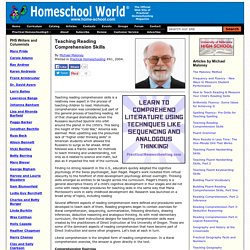
Historically, comprehension was considered just part of the general process of teaching reading. All of that changed dramatically when the Russians launched Sputnik into orbit around the planet in the 1950's. This being the height of the "Cold War," America was alarmed. Most upsetting was the presumed lack of "higher order thinking skills" in American students which allowed the Russians to surge so far ahead. What followed was a frantic search for methods to teach thinking and understanding, not only as it related to science and math, but also as it impacted the rest of the curricula.
Finding no strong research in the U.S., educators quickly adopted the cognitive psychology of the Swiss psychologist, Jean Piaget. Teaching Main Idea of Nonfiction Text *3 Different Ways* - Teaching to Inspire with Jennifer Findley. By far, one of the hardest skills to teach is Main Idea.
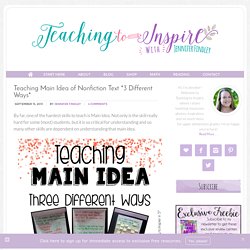
Not only is the skill really hard for some (most) students, but it is so critical for understanding and so many other skills are dependent on understanding that main idea. Keeping this in mind, I tackled teaching main idea of nonfiction text this week. Throughout the entire week we focused on finding the main idea through a variety of strategies. *Before you look at these anchor charts a little warning: I make all of my charts with my kids. I only have the mini lesson statement written before hand and maybe some other items. Main Idea Strategy: Using Key Words We started reading a high interest article from Zoobooks about Owls that was projected onto the smartboard the first day. As you can see, I taught the kids that key words are either bolded, repeated (keeping in mind words that are repeated through synonyms) or they match the heading or the title.
Main Idea Strategy: What To Do When You Have Choices. 21 Anchor Charts That Teach Reading Comprehension. This blog is sponsored by Questar Assessment, a K–12 assessment-solutions provider focused on building a bridge between learning and accountability.
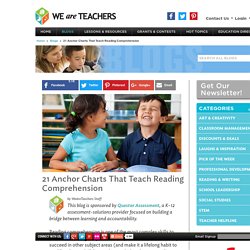
Reading comprehension is one of the most complex skills to teach. It’s also arguably the most important. Students will only succeed in other subject areas (and make it a lifelong habit to read for pleasure) if they understand what they are reading on an ingrained level. Many factors go into the development of reading comprehension, including building an extensive vocabulary, asking questions, making connections and visualization. Books for Making Inferences and Predictions. Making inferences and predictions are highly related comprehension strategies.
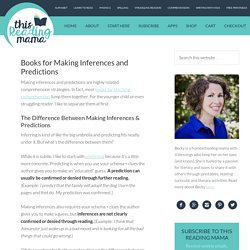
In fact, most books for teaching comprehension lump them together. For the younger child or even struggling reader, I like to separate them at first. The Difference Between Making Inferences & Predictions Inferring is kind of like the big umbrella and predicting fits neatly under it. But what’s the difference between them? While searching for further explanation on the difference between the two, I ran across this article from Teach Thought, which does a fantastic job of explaining the differences further. Books for Making Inferences and Predictions Below are some of our favorite books for making inferences and predictions.
*This post contains affiliate links. Books for Making Predictions Any book with a clear story line and good “cliff hangers” makes for a good book to use for making predictions. What Do You Do With a Tail Like This? Books for Making Inferences I love, love, love Ring! Enjoy! Teaching Children to Visualize to Build Reading Comprehension - Proud to be Primary. Teaching children to comprehend and make sense of what they are reading is vital to building literacy.
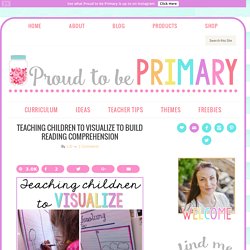
Going beyond teaching decoding strategies and how to build fluency, they need to be taught how to understand what they read through reading comprehension strategies, such as connecting, visualizing, questioning, inferring, etc. Teaching children to visualize to build reading comprehension is so important. Visualizing is the ability to hear a story and have a mental image about the text. This helps the child create meaning for themselves in their own way based on their own previous experiences. Today I will share some of the lessons I use to teach children to visualize what they read.
We listened to poetry and drew pictures with chalk on dark construction paper. Next, I read a story while my student teacher drew what she heard me read. Untitled. Third Grade Doodles: RISE Up for Higher Level Reading Comprehension. Hello Friends!!
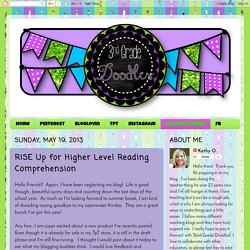
Again, I have been neglecting my blog! Life is good though...beautiful sunny days and counting down the last days of the school year. As much as I'm looking forward to summer break, I am kind of dreading saying goodbye to my supersweet thirdies. They are a great bunch I've got this year! Any hoo...I am super excited about a new product I've recently posted. Since I left first grade and began teaching third, the importance of increasing the level of reading comprehension has become critical. For several years, I have used the CAFE Menu by the Two Sisters. I came up with the RISE Menu, which is an acronym for Retell, Infer, Synthesize, Envision & Connect.
This resource pack contains the materials needed to create a classroom display (multiple designs and sizes are available), an 8 1/2 x 11 version of the complete menu (with room to add more activities), response sheets for fiction and non-fiction, a rubric for these responses, and a few different record keeping sheets.